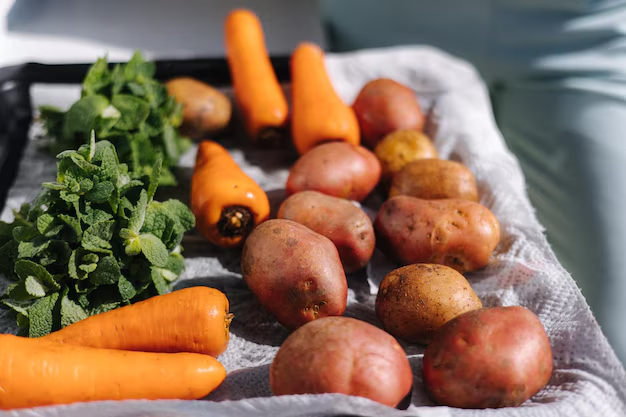Best Practices for Keeping Potatoes Fresh in the Refrigerator
Storing potatoes might seem straightforward, but many of us have faced the disappointment of finding sprouted, green, or shriveled potatoes after seemingly taking the right precautions. In this comprehensive guide, we'll explore how to best store potatoes in the refrigerator, uncover the myths and truths about refrigerating these versatile vegetables, and provide practical advice to extend their shelf life.
🥔 Understanding Potato Storage Basics
Potatoes are a staple in many kitchens due to their versatility and nutritional benefits. However, keeping them fresh can be a bit of a conundrum. Temperature and humidity are key players in the storage game, and they dramatically affect the longevity and quality of potatoes.
Why Temperature Matters
Cold Temperatures: Contrary to common belief, colder isn’t always better when it comes to potato storage. Potatoes stored in the refrigerator can undergo a process called cold-induced sweetening, where their starches convert to sugars, affecting taste and cooking behavior.
Optimal Temperature: Potatoes are best kept in a cool, dark place at about 45-50°F (7-10°C). However, since not everyone has a root cellar or a similar space, people often turn to refrigerators out of necessity.
Importance of Humidity
High Humidity: Potatoes benefit from a relatively high humidity level to prevent them from drying out. Refrigerators tend to be dry, which can lead to shriveling. Adding a humidifier within your fridge drawer can help maintain the needed moisture levels.
📦 Key Steps to Store Potatoes in the Refrigerator
While refrigerators aren't ideal for long-term storage, they can be used effectively for short periods with certain precautions. Here’s how:
1. Selection of Potatoes
Start strong by choosing potatoes that are firm, smooth, and free from blemishes or sprouts. Look for variety-specific preferences, as not all potatoes react the same to cooler temperatures.
2. Preparation Before Storage
- Cleaning: Brush off excess dirt but avoid washing the potatoes before storing, as moisture can lead to rot.
- Initial Storage: Allow the potatoes to "cure" in a cool, dark place for up to two weeks. This toughens their skin, making them more durable for cooler temperatures.
3. Packaging Tips
- Use Paper Bags: Put potatoes in a paper bag or cardboard box to absorb excess moisture.
- Ventilation is Key: Ensure the bag or box has holes or slits for air circulation.
- Avoid Plastic Bags: They trap moisture, increasing the risk of rot and sprouting.
4. Refrigeration Tips
- Placement: Store in a warmer part of the fridge, like the crisper drawer, to minimize the cold’s impact on starch conversion.
- Monitor: Inspect frequently for signs of sprouting or disease. Remove any compromised potatoes immediately to protect the others.
🔍 Exploring the Effects of Refrigeration
Potential Drawbacks
- Flavor Changes: Refrigeration can increase sweetness but may lead to an undesirable taste and color when cooked, especially in frying.
- Texture Alterations: Prolonged refrigeration can lead to gritty or mealy textures, unappealing for many potato dishes.
Possible Benefits
- Sprout Inhibition: The cooler temperature can slow sprouting, which is beneficial if the refrigerator is the only storage option.
- Short-term Solution: For those without a cool, dry place due to climate or urban living restrictions, refrigeration offers a temporary respite.
🌿 Additional Potato Storage Tips
Consider these alternative methods to maintain potato freshness:
Ideal Storage Alternatives
- Basements or Cellars: These are often naturally cool and dark, perfect for storing potatoes long-term.
- Pantries: A pantry or kitchen cabinet away from heat sources might work well, provided it's ventilated and not too hot.
Balancing Light Exposure
- Avoid Sunlight: Light exposure turns potatoes green and produces solanine, a toxic compound.
- Cover with Cloth: Use a breathable cloth or burlap sack to cover potatoes if they’re exposed to any light source in a fridge or pantry.
Common Storage Mistakes
- Don’t Store Near Onions: Onions emit gases that speed up spoilage in potatoes.
- Mismanagement of Space: Keep a close check on storage space to prevent crushing or bruising the potatoes.
🌟 Potato Storage Quick Tips and Takeaways
Here's a visually distinct summary for quick reference:
- 🥔 Select Firm Potatoes: Choose potatoes with no sprouts or soft spots.
- 🌡️ Mind the Temperature: Store in the fridge only if necessary, on a warmer shelf or drawer.
- 💧 Humidity Overhaul: Utilize the crisper drawer with added humidity as needed.
- 📦 Right Packaging: Use paper bags for airflow and moisture control.
- 🚫 Avoid Bright Spots: Prevent exposure to light to avoid greening of potatoes.
- 👯♂️ Separate from Onions: Don't store potatoes with onions.
🔄 Embracing Innovations and Storage Trends
As consumers demand more sustainable living solutions, innovations in food storage are constantly emerging. Here are a couple of trends that may influence your potato storage in the future:
Smart Storage Solutions
- Temperature and Humidity Sensors: Devices that alert you when conditions are suboptimal can be integrated into storage spaces, ensuring greater precision in home food storage.
- Sustainable Materials: Advancements in eco-friendly packaging, such as biodegradable materials that regulate moisture and promote aeration, could change how we store potatoes and other produce.
Understanding 'Best By' Insight
- Expiry Awareness: While potatoes don't come with a 'best by' date, knowing the approximate storage life allows you to plan consumption effectively, minimizing waste.
Potatoes, when stored correctly, maintain their texture and flavor, enabling you to enjoy them longer. This guide provided insights into storing them in the refrigerator, including the steps to follow and factors to consider. While the fridge might not outperform traditional storage methods, these tips could help adapt to modern living conditions with minimal compromise in quality. 🌿
